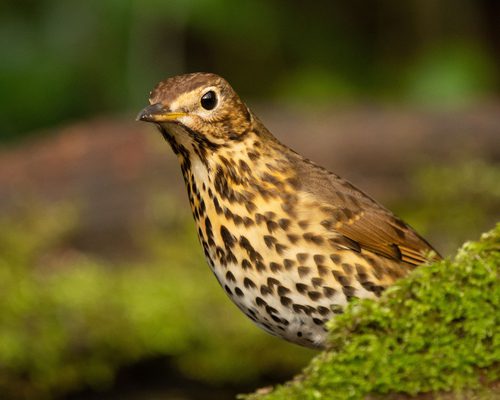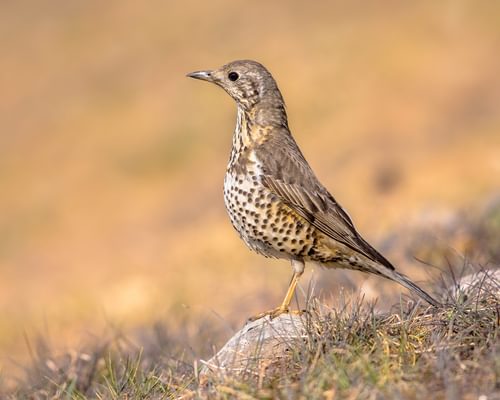Dusky Thrush
Turdus eunomus
Visual Identification
Appearance
The Dusky Thrush is a medium-sized bird with distinctive plumage. Its upperparts are dark brown, contrasting with a white eyebrow and black-streaked white underparts. The sides of the breast and flanks are marked with bold black crescents.
Both sexes have similar plumage, though females may be slightly duller. Juveniles are browner overall with less distinct markings. In winter, adults develop buff-tipped feathers, giving them a slightly scaly appearance.
Size
Length
23cm to 25cm
Wingspan
36cm to 40cm
Weight
65g to 90g
Colours
Males and females have similar plumage
Primary Colour
Brown Black White
Secondary Colour
Buff Grey
Beak Colour
Black Yellow
Leg Colour
Brown
Habitat and Distribution
Habitats
Woodland
Garden
Wetland
Coastal
Urban
Farmland
Grassland
Desert
Tundra
Rainforest
Mountain
Savanna
Distribution
Dusky Thrushes breed in the taiga and tundra regions of eastern Siberia. Their summer habitat includes open coniferous forests, forest edges, and scrubland near water bodies. During winter, they migrate to eastern and southeastern Asia.
In their wintering grounds, they inhabit various habitats, including woodlands, orchards, and agricultural areas. Rare vagrants occasionally appear in western Europe, including the UK, typically during autumn migration.
Elevation Range
Sea level to 3,000 meters
Climate zones
Subarctic, Temperate, Subtropical
Distribution Map
This map gives you a rough idea of where you might spot a Dusky Thrush. The coloured areas show countries where these birds have been seen.
A few things to keep in mind:
- Birds might not be everywhere in the coloured areas, for example, they may be present around the coast of that country
- Where birds live can change with seasons and available food
- This map is quite simple - it doesn't show exact locations
We're working on making our maps even better! Soon, we hope to show you:
- More detailed maps for bigger countries, including state and region
- How birds move around during different seasons
Distribution by Region
Behaviour and Ecology
Bird Attributes
This feature is in beta. We'd love your feedback to improve it!
Share your thoughtsBird Attributes Explained
Our bird attributes system rates various aspects of a bird's capabilities on a scale of 0-100, based on data from field observations, scientific studies, and expert knowledge.
Attribute Categories:
- Agility: Manoeuvrability, speed, and grace in flight or movement.
- Strength: Physical power, often correlating with size and hunting abilities.
- Adaptability: Ability to thrive in various environments or changing conditions.
- Aggressiveness: Territorial behaviour and assertiveness, particularly during breeding seasons.
- Endurance: Stamina, often seen in migration patterns or foraging behaviours.
Understanding the Ratings:
- 0-20: Very Low
- 21-40: Low
- 41-60: Average
- 61-80: High
- 81-100: Very High
Remember, these attributes are relative to other bird species and don't necessarily indicate superiority.
Hover over the icon next to each attribute for more information.
Tap the icon next to each attribute for more information.
Agility
Reflects the bird's manoeuvrability, speed, and grace in flight or movement.
The Dusky Thrush demonstrates considerable agility in its ground-foraging behaviour, hopping and running in short bursts. Its ability to navigate through varied habitats from sea level to 3000 metres elevation also suggests good manoeuvrability.
Strength
Indicates the bird's physical power, often correlating with size and hunting abilities.
As a medium-sized thrush, it possesses moderate strength. Its ability to fly at speeds up to 50 km/h during migration indicates decent muscular power, though it's not exceptionally strong compared to larger bird species.
Adaptability
Represents the bird's ability to thrive in various environments or changing conditions.
The Dusky Thrush shows high adaptability, inhabiting diverse environments from taiga and tundra to woodlands and agricultural areas. Its ability to adjust its diet seasonally and survive in various climate zones from subarctic to subtropical demonstrates remarkable adaptability.
Aggressiveness
Measures the bird's territorial behaviour and assertiveness, particularly during breeding seasons.
While the Dusky Thrush can be territorial during breeding season and has alarm calls, it's generally not known for aggressive behaviour. They often form mixed feeding flocks with other thrush species, suggesting a relatively peaceful nature.
Endurance
Reflects the bird's stamina, often seen in migration patterns or foraging behaviours.
The Dusky Thrush's long-distance migration, with some individuals travelling over 5,000 km annually, indicates impressive endurance. Their ability to thrive across a wide elevation range and diverse habitats further supports their high endurance rating.
Diet
The Dusky Thrush primarily feeds on invertebrates, including earthworms, insects, and their larvae. During autumn and winter, it supplements its diet with various berries and fruits. They often forage by probing the ground with their beaks, turning over leaves to find hidden prey.
Behaviour
Dusky Thrushes are often seen foraging on the ground, hopping and running in short bursts while searching for food. During the non-breeding season, they are generally solitary or found in small groups. When alarmed, they often perch upright on exposed branches, bobbing their tails and giving sharp alarm calls.
Vocalisation
The Dusky Thrush has a varied vocal repertoire. Its song is a series of flute-like whistles and warbles, often delivered from a high perch. The alarm call is a sharp, harsh 'chack' or 'tuk-tuk-tuk'.
During migration, they frequently give a soft, plaintive 'seep' call, helping to maintain contact within flocks.
Nesting & Breeding
Breeding occurs from late May to July in their Siberian range. Males establish territories and attract females with melodious songs. Pairs form for the breeding season.
Nests are typically built in trees or shrubs, constructed of twigs, grass, and moss, lined with finer materials. Females lay 4-5 pale blue eggs with reddish-brown spots.
Incubation lasts about 13-14 days, primarily by the female. Both parents feed the nestlings, which fledge after approximately 13-15 days. Fledglings remain dependent on their parents for several weeks after leaving the nest.
Conservation and Status
Global Conservation Status
While the Dusky Thrush is currently listed as Least Concern, habitat loss in its breeding and wintering grounds poses a potential threat. Climate change may also affect its migration patterns and breeding success. Ongoing monitoring is crucial to detect any population changes.
Population Data
Global Population Estimate
Unknown
Global Population Trend
Trend data may be uncertain or fluctuating
Birdwatching Tips
- Look for Dusky Thrushes in open woodlands or at forest edges
- Listen for their distinctive 'chack-chack' call, especially during migration
- Observe ground-feeding behaviour in fields or grassy areas
- In the UK, check coastal areas during autumn migration for rare sightings
Additional Information
Quick Facts
Predators
Main predators include birds of prey such as hawks and falcons, as well as small carnivorous mammals like martens and foxes. Nest predators may include corvids and squirrels.
Did You Know?
- Dusky Thrushes can fly at speeds of up to 50 km/h during migration.
- They have been known to form mixed feeding flocks with other thrush species in winter.
- Some individuals have been recorded travelling over 5,000 km during their annual migration.
Similar Birds
References
- 1
website: BirdLife International. 2016. Turdus eunomus. The IUCN Red List of Threatened Species 2016: e.T22736111A104201968.
View source
Share Your Feedback
We value your opinion! Let us know what you think about this bird page.

